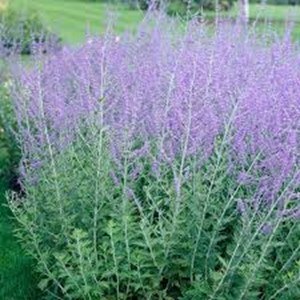It's silver gray fragrant foliage and lavender flowers make a bold statement in the garden. It attracts butterflies, bees, and hummingbirds whilst avoiding deer and major disease. What a remarkable plant to grow in your own garden.

About
Russian Sage, also known as Salvia Yangii, neither truly Russian or sage is native to Central Asia and was named in honor of a Russian General. It is a member of the mint family and gives off a sage-like aroma when the leaves are crushed. As with other members of the mint family, it likes to spread. Its silver-gray fragrant foliage and lavender flowers make a bold statement in the garden. The spiky clusters of flowers bloom from late spring until autumn. It attracts butterflies, bees, and hummingbirds, is resistant to damage by deer, and has no serious pest or disease problems.
Gardener Tips for Growing Russian Sage
It is best planted in well-drained soil in full sun. Once it is established it is drought resistant. Mature plants can reach 3 to 5 feet in height with a spread of 2 to 4 feet. Leaving the stems up in the fall provides winter interest, usually able to brighten up the garden space in those stark months. Cut the stems to 4-6" in the spring to stimulate the new growth.
Perennial Plant of The Year Recipient
Due to its low maintenance and showy, tubular flowers it was named Perennial Plant of the year in 1995.
Written By: Penn State Master Gardener Patricia Duffy

